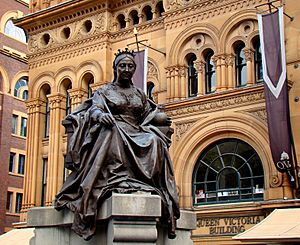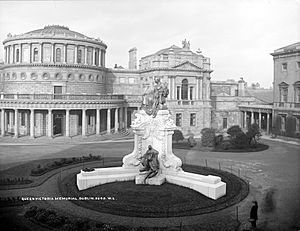Statue of Queen Victoria, Sydney facts for kids
The large Statue of Queen Victoria you can see in Sydney, New South Wales, Australia, was created by a sculptor named John Hughes in 1908. It's made of bronze and sits on the corner of Druitt and George Street, right in front of the famous Queen Victoria Building. This statue actually started its life far away in Dublin, Ireland! It was the very last royal statue ever put up in Ireland.
There's also another bronze statue of Queen Victoria standing nearby, in Queen's Square.
Contents
How the Statue Was Made
Queen Victoria visited Ireland in April 1900. This visit made the Royal Dublin Society suggest building a special monument to her. When she passed away nine months later, people became even more eager to create the statue.
John Hughes, who taught modelling at the Dublin Metropolitan School of Art, was chosen to make the statue. He even moved his workshop to Paris to use a special method called lost-wax casting to create the bronze statue. This was his most important project yet! Nearly ten years later, on February 17, 1908, the statue was officially revealed in Dublin, Ireland. It was placed in the courtyard of Leinster House. A big ceremony took place with 1000 soldiers, and the Lord Lieutenant (a high-ranking official) said they were there to celebrate "a great personality and a great life."
The statue sat on top of a tall portland stone column, which Hughes also designed. At the bottom of the column were three smaller sculptures. These were called "Fame," "Hibernia at Peace," and "Hibernia at War." "Hibernia" is an old, poetic name for Ireland. The "Hibernia at War" group also showed "Erin and the Dying Soldier," which was a way to remember the loyalty of Irish soldiers in the Boer War.
The Statue's Journey
From Ireland to Storage
In 1922, about 14 years after the statue was put up, Leinster House became the home of the Irish parliament, called the Oireachtas. At this time, many people in Ireland felt strongly about their own country and didn't want a British queen celebrated in such an important national place.
In August 1929, a newspaper called The Irish Times reported that people were talking about moving the statue. They felt it didn't fit with national feelings and made the parliament buildings look less beautiful. So, in July 1948, the statue was taken down from its original spot. A carpark was built there instead!
The statue was then moved by lorry to the Royal Hospital Kilmainham. This hospital was once considered as a place for the parliament and was used to store items belonging to the National Museum of Ireland. Today, it's the Irish Museum of Modern Art. There were ideas to send the sculpture to London, Ontario in Canada, but this didn't happen because neither the Canadian nor the Irish governments wanted to pay for the transport. In February 1980, the statue was moved again, this time to a yard behind an old children's reformatory (a type of school for young people who had broken the law) in Daingean, County Offaly.
The smaller sculptures that were part of the statue's base are now kept at Dublin Castle.
Finding a New Home in Australia
In the mid-1980s, the famous Queen Victoria Building in central Sydney was being repaired and updated after being unused for many years. People were looking for suitable public art to place at its entrance. Neil Glasser, who worked for the company doing the renovations, traveled to several former British colonies, hoping to find a statue.
After a lot of searching, he found the Queen Victoria statue sitting in tall grass behind the old reformatory in Ireland. He suggested moving it to Australia. To get permission, Glasser contacted John Teahan, the Director of the National Museum of Ireland. Sydney's Lord Mayor also contacted the Irish Ambassador in Canberra. In August 1986, the Irish Prime Minister, Garret FitzGerald, agreed to give the statue to Australia. It was described as a "loan until recalled." However, old government papers later showed that the finance minister, John Bruton, and John Teahan were against the plan. They felt the statue was an important work by an Irish artist and part of Ireland's history.
The statue was shipped by sea to Australia that same year. It was cleaned up and repaired in Sydney. Finally, 43 years after it was last on display, it was put in its current spot. On Sunday, December 20, 1987, the Chief Commissioner of Sydney, Eric Neal, officially revealed the statue. The Irish media found it quite funny that the British Queen was "transported" to Australia by ship, just like prisoners used to be!
Islay the Dog Statue
Near the Queen Victoria statue, there's another small statue of a dog. This is "Islay," Queen Victoria's favorite pet, a Skye Terrier. The statue shows Islay begging above a wishing well. This well collects donations for the Royal Institute for Deaf and Blind Children.
The Sydney sculptor Justin Robson made this bronze dog statue for $10,000. He based it on a drawing the Queen made in 1843. The statue's location actually helps to hide a ventilation shaft for the new carpark under the renovated building.
The wishing well also has a poem about Islay's story, which is even translated into Braille for blind people. It includes four wise sayings about giving in six different languages, and a piece of stone from Blarney Castle, Ireland. Since 1998, a recorded message asking for donations plays from hidden speakers every so often. The message is "spoken" by Islay himself! He says, "Because of the many good deeds I've done for deaf and blind children, I have been given the power of speech," before thanking people for their donations. A local radio person, John Laws, did the voice for Islay, and the recording ends with two barks, also by Laws.




